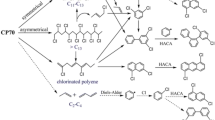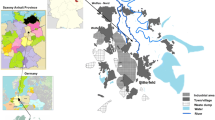Abstract
Chlorinated hydrocarbons such as tetrachloroethylene (PCE) and trichloroethylene (TCE) are not directly mineralized, but rather are transformed into one or more intermediate compounds before converting into a final compound. Since the biotransformation rate coefficients of each intermediate compound are different, the coefficients in each step of reductive dehalogenation must be determined to establish an effective treatment operation. These parameters can be estimated by fitting the experimental data to Michaelis–Menten equation. In this study, we introduce a methodology, using both the curve-fitting and graphical methods, to estimate the rate of maximum biotransformation and half-saturation coefficients of parent and intermediate compounds. First-order rate coefficients are also estimated by simplifying the Michaelis–Menten equation for both curve-fitting and graphical methods. The results show that both methods produce similar parameter values for each rate equation. Estimated first-order kinetic parameters are employed to predict the compound concentrations from the analytical solutions of governing equations for sequential dehalogenation. Comparisons of predicted and experimental values show favorable agreement.
Similar content being viewed by others
References
Atkins, G. L. and Nimmo, A. I.: 1973, The reliability of Michaelis constants and maximum velocities estimated by using the integrated Michaelis–Menten equation, Biochem. J. 135, 779–784.
Barrio-Lage, G., Parsons, F. Z. and Nassar, R. S.: 1987, Kinetics of the depletion of trichloroethene, Environ. Sci. Technol. 21, 366–370.
Bateman, H.: 1910, Solution, of a system of differential equations occurring in the theory of radioactive transformation, Proceedings of the Cambridge Philosophical Society, Vol. 15, 423 p.
Benedict, M., Pigford, T. H. and Levi, H. W.: 1981, Nuclear Chemical Engineering, McGraw-Hill, New York, pp. 77–78.
Corapcioglu, M. Y. and Hossain, M. A.:1991a, Methanogenic biotransformation of chlorinated hydrocarbons in groundwater, J. Environ. Eng. ASCE 117, 47–65.
Corapcioglu, M. Y. and Hossain, M. A.: 1991b, Estimating biotransformation rate constants for sequential reductive dehalogenation reactions, J. Environ. Eng. ASCE 117, 631–639.
De Bruin, W. P., Kotterman, M. J. J., Posthumus, M. A., Schraa, G. and Zehnder, A. J. B.: 1992, Complete biological reductive transformation of tetrachloroethene to ethane, Appl. Environ. Microbiol. 58, 1996–2000.
Friedlander, G. and Kennedy, J. W.: 1955, Nuclear and Radiochemistry, Wiley, New York, pp. 129–130.
Gaudy, A. and Gaudy, E.: 1980, Microbiology for Environmental Scientists and Engineers, McGraw-Hill, New York.
McCarty, P. L.: 1972, Stoichiometry of biological reactions, Proceedings of the International Conference Toward a Unified Concept of Biological Waste Treatment Design, Atlanta, GA.
McCarty, P. L.: 1984, Application of biological transformations in groundwater, Proceedings of the Second International Conference on Ground Water Quality Research, Stillwater, OK, pp. 6–11.
Oldenhuis, R., Vink, R. L. J. M., Janssen, D. B. and Witholt, B.: 1989, Degradation of chlorinated aliphatic hydrocarbons by Methylosinus trichosporium OB3b expressing soluble methane monooxygenase, Appl. Environ. Microbiol. 55, 2819–2826.
Segel, I. H.: 1974, Enzyme Kinetics: Behavior and Analysis of Rapid Equilibrium and Steady-state Enzyme Systems, Wiley, New York.
Tandol, V., Distefano, T. D., Bowser, P. A., Gossett, J. M. and Zinder, S. H.: 1994, Reduction dehalogenation of chlorinated ethenes and halogenated ethanes by a high-rate anaerobic enrichment culture, Environ. Sci. Technol. 28, 973–979.
Vogel, T. M. and McCarty, P. L.: 1987, Rate of abiotic formation of 1,1-dichloroethylene from 1,1,1-trichloroethylane in groundwater, J. Cont. Hydrol. 1, 299–308.
Wilson, J. T., Leach, L. E., Henson, M. and Jones, J. N.: 1986, In situ biodegradation as a groundwater remediation technique, Ground Water Monit. Remediation 6, 56–64.
Wu, W. M., Nye, J., Hickey, R. F., Jain, M. K. and Zeikus, J. G.: 1995, Dechlorination of PCE and TCE to ethylene using an anaerobic microbial consortium, In: R. E. Hinchee, A. Leeson and L. Semprini (eds), Bioremediation of Chlorinated Solvents, Battelle Pr., Columbus, pp. 45–52.
Author information
Authors and Affiliations
Corresponding author
Rights and permissions
About this article
Cite this article
Yavuz Corapcioglu, M., Sung, K. & Kim, J. Parameter Determination of Sequential Reductive Dehalogenation Reactions of Chlorinated Hydrocarbons. Transport in Porous Media 55, 169–182 (2004). https://doi.org/10.1023/B:TIPM.0000010677.47179.f1
Issue Date:
DOI: https://doi.org/10.1023/B:TIPM.0000010677.47179.f1




